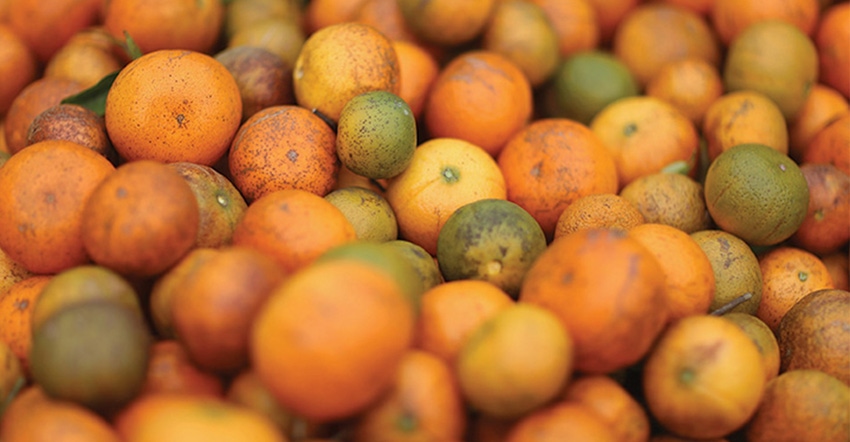
Very few of you have ever owned orange trees or even seen an orange tree in person. But a large number of you drink orange juice. Some juice from certain brands that once came from Florida oranges is now imported from other countries. Why? Because an insidious disease called citrus greening is rapidly taking its toll on the citrus industry in Florida.
You may be wondering why you should care. After all, you raise corn, soybeans and wheat, not oranges. It’s the cooperation going on behind the scenes to save an industry that’s worth watching. Funds are being raised, agreements are being forged, and fierce competitors are supporting the same cause. Would this happen if soybeans, corn, hogs or cattle were under attack from a widespread enemy?
Here’s what’s at stake. The Florida Department of Citrus reports that growers produced 205 million boxes of oranges in 1995-96. By 2005-06, that number was 147 million boxes. For 2015-16, production dropped to 81.5 million boxes. Adrian Percy, head of research and development for crop science at Bayer, says unless solutions are found, Florida could be out of the citrus business in 10 to 15 years.
Enter Bayer
Bayer and the Citrus Research and Development Foundation signed a research collaboration agreement to find solutions to citrus greening. Officials feel it’s prudent because there are currently no effective treatment options against the bacteria that cause the disease.
Bayer’s role will be providing access to its disease control know-how. The company will also coordinate public and private research to find novel solutions to the disease.
The Citrus Research and Development Foundation will organize financing. Two leaders in the juice industry and normally fierce competitors, PepsiCo Inc. and Coca-Cola Co., are financially supporting the partnership. That’s how dire industry leaders view the threat. Would leading competitors in other segments of agriculture cooperate to combat a common threat?
Possible solutions
Research will focus on a broad set of possible tools to use against the disease, experts say. The goal is to identify biological disease control solutions or molecules that modulate the plant’s own immune defense system. Officials say the hope is finding one or more solutions that growers can use soon. Bayer would further develop and commercialize other potential treatments.
The ultimate goal is keeping growers in business until disease-tolerant trees become available.
What-if scenario?
There is no indication from Bayer or anyone else that the solution might involve bioengineering. But suppose for a moment that it did. Would the public accept GMO oranges if it meant keeping fresh Florida orange juice on tables?
It’s a fair question, and a perplexing one. Right now, at least one juice product that once used Florida oranges but now imports juice includes a “non-GMO” seal on every bottle.
Plenish and Vistive Gold cooking oils from high-oleic soybeans are finally hitting the market. So far consumers are accepting these healthier oils made from high-oleic GMO soybeans. Prognosticators 20 years ago said that once GMOs helped produce improved products for consumers, they would accept them.
The time might be coming to see if that prediction holds true.
About the Author(s)
You May Also Like




